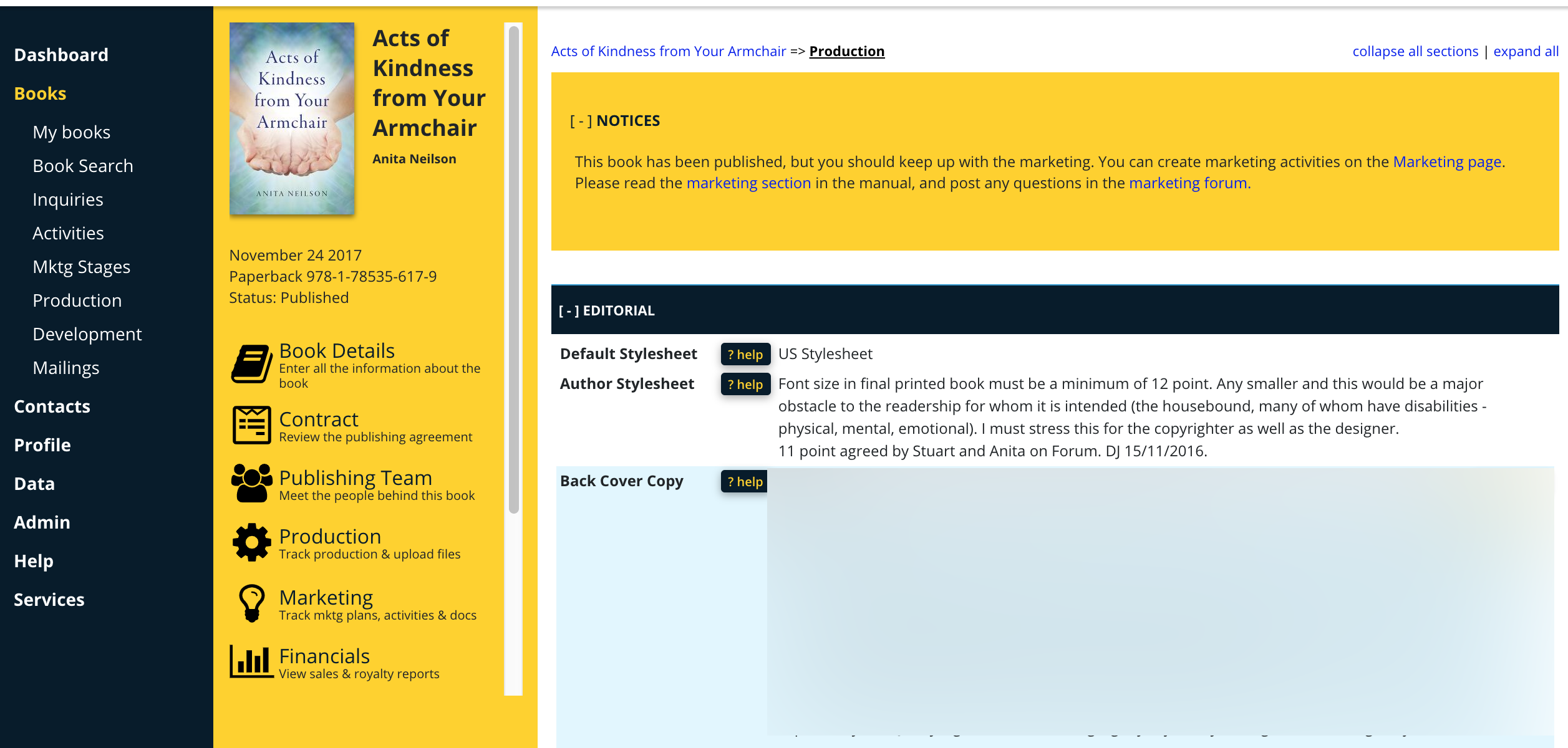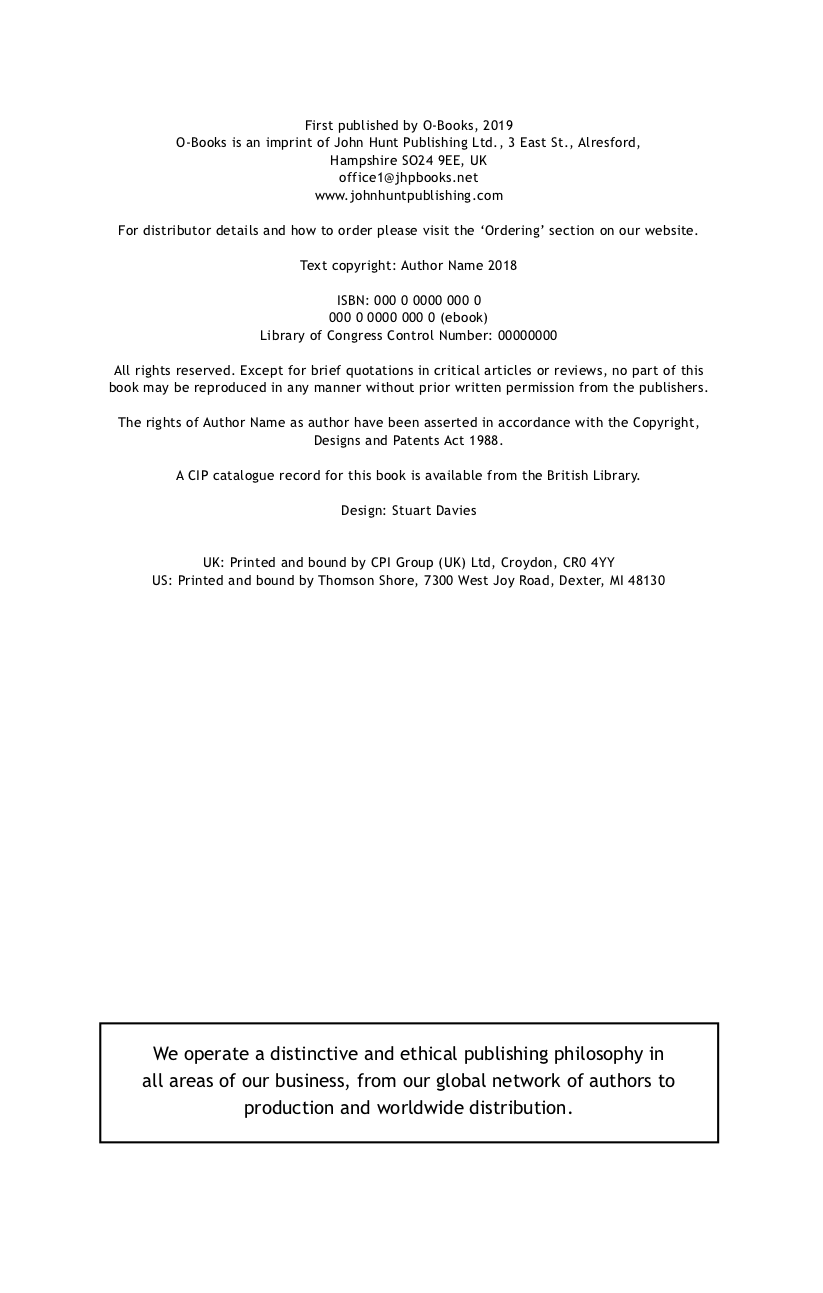AUTHOR STYLESHEET

Your page in the Books Database covering editorial, production and print opens when the contract is agreed. There is a lot of information on this page. The heart of it is in the Production Workflow section, where you upload your final manuscript, and which tracks the progress through editing and design to final files. But it is useful to be aware of the rest. We do not, for instance, put books through without comments from the author first in the Author Stylesheet.

The Production Workflow section tracks the progress through editing and design to final files.
The Author Stylesheet is where we ask you to note any preferences you have regarding our treatment of your manuscript. It's the section on your book's Production page in which you can leave notes for our copyeditors and designers.
- In the case of copyediting, this could mean specifying whether you want the final text to use English spelling or American spelling (mark your preference in Default Stylesheet), or letting the copyeditor know about specific terms you don't want anyone to correct. For example, you may be concerned that the copyeditor will change "systemic" to "systematic" because the latter is more familiar. The Author Stylesheet is where you'd make note of this kind of jargon, especially if it is specific to your book or field.
- As for designing, it could mean asking the designer to make sure all new chapters begin on the right-hand page or the left-hand page. If you don't mention anything, the designer will treat the book as standard and design it conventionally.

Author Stylesheet from Acts of Kindness from Your Armchair, Ayni Books
Notes
- Copyediting is compulsory: It is very difficult for an author to be aware of all possible faults. Copyediting helps ensure that your book will be acceptable to readers, and we want to make sure we've done our part. If you feel your manuscript is perfect, and you've already had it copyedited elsewhere, you can mention this in the Author Stylesheet and specify that you only want obvious typos fixed. Our copyeditor will see it and keep it in mind. This is done at our cost.
- Copyediting level: Our copyeditors do not research and check foreign, specialist or ancient words, accents or spellings that are not in common use. If you have to use these, get them right in the beginning, make a reference to them in the style notes. Assume that the copyeditor does not know your subject area. We tend to send academic books to academically minded copyeditors, popular ones to more popularly minded, and so on, but they may still not be familiar with your particular specialty. We use editors as far as we can consistently within the different imprints, but those can still range widely. If there are key terms in your manuscript that are important to the case being made (e.g. "panentheism" rather than "pantheism") do make a note of them in the Stylesheet, and double-check that copyeditors in their benighted ignorance haven’t changed them to something they are more familiar with.
- Detail: The more specific you can be, the better a job the copyeditor can probably do. Otherwise, the editor may make some judgments that you disagree with. It’s a very subjective area. Words and styles change. For some authors today it’s important to have “Nature” with a capital “N,” for others (and for most style conventions) it’s an error. It doesn’t matter how long your comments are, better to flag these points up before the copyediting starts, rather than having to change them when the copyedited manuscript comes back to you.
- Special typefaces and symbols: Avoid them as far as possible. We may have to ask for a payment on these, along with charts, diagrams and tables. If you do need to use them, anything at all out of the ordinary (it might be for Greek lettering, Sanskrit, symbols, or whatever…) make a note of the typeface and source. The designer may need to find it. They probably won’t have it on their computer. If you can’t do that, don’t use them.
- Notes for the designer: Some points you make will need to be read by the designer as well as the copyeditor. Make this clear, head them: “Notes for the designer.” If there is to be an index, mention that so that room can be left for it. Cover how you want diagrams, charts and other illustrated material treated. Where, for instance, you want the captions placed. If you have any particular requests on the layout, such as having chapters start on a right-hand page, or half-way down the page, or particular type faces, or heading designs, mention them on the Stylesheet. Otherwise the designer won’t necessarily follow the style you set in the manuscript. Please note: We will endeavour to follow your instructions where appropriate, but sometimes design requests aren't feasible, or may not translate to print as well as you think. Our designers are experts and will have the final say.
- Copyright page and last page: Our copyright page is standard. The editor/designer will put in the correct details as regards author, publication date, ISBN etc. If you have any other copyright details that you would like to add, such as for pictures or cover design if you have supplied that, please make a note of it. On the last page of the text we put a note about the imprint. If your title is more academic or for some similar reason this wording is not suitable, make a note in the Stylesheet.
- Style of previous book: Please do not assume that if you have published with us before the style conventions you have marked for a previous book will be followed on a new one. The copyeditor will almost certainly be different. Copy the comments that you made in your first Author Stylesheet to the new one.
Below: sample copyright page.
